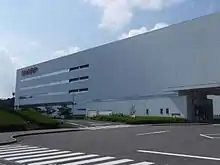Sharp Corporation
Sharp Corporation (シャープ株式会社, Shāpu Kabushiki-gaisha) is a Japanese multinational corporation that designs and manufactures electronic products, headquartered in Sakai-ku, Sakai, Osaka Prefecture. Since 2016 it has been majority owned by the Taiwan-based Foxconn Group.[4][5][6] Sharp employs more than 50,000 people worldwide. The company was founded in September 1912 in Tokyo and takes its name from one of its founder's first inventions, the Ever-Sharp mechanical pencil, which was invented by Tokuji Hayakawa in 1915.
The Sharp logo used since 1960 | |
 Sharp's headquarters at its factory in Sakai-ku, Sakai, Osaka Prefecture | |
Native name | シャープ株式会社 |
|---|---|
Romanized name | Shāpu kabushiki gaisha |
| Formerly | Hayakawa Metal Works (1924–1942) Hayakawa Electric Industry Co., Ltd. (1942–1970) Sharp Electric Co. (spin-off) (1956–1967) |
| Type | Public KK |
| TYO: 6753 | |
| Industry | Consumer electronics |
| Founded | 15 September 1912 Tokyo, Japan[1] |
| Founder | Tokuji Hayakawa[1] |
| Headquarters | Sakai-ku, Sakai, Osaka Prefecture, Japan |
Area served | Worldwide |
Key people | Jeng-wu Tai[2] (President) |
| Products | Televisions, audiovisual, home appliances, information equipment, ICs, solar cells, mobile phones, fax machines, electronic components, calculators, LCD panels, Automated Unmanned Ground Vehicles (A-UGV) |
| Revenue | |
| Total assets | |
| Total equity | |
| Owner | Foxconn (65.93%) |
Number of employees | 52,876 (2020) (Foxconn 803,126)[3] |
| Website | global.sharp |
History
Early years 1912-1945
In 1912, Tokuji Hayakawa founded a metal workshop in Tokyo. The first of his many inventions was a snap buckle named 'Tokubijo'. Another of his inventions was the Ever-Sharp mechanical pencil in 1915, from which the Sharp Corporation derived its name.[7] After the pencil business was destroyed by the 1923 Great Kantō earthquake, the company relocated to Osaka and began designing the first generation of Japanese radio sets. These went on sale in 1925.
The company was established as "Hayakawa Metal Works" in 1924, in Tanabe-cho, Osaka. In 1942, the name was changed to "Hayakawa Electric Industry Company".
1945-1999
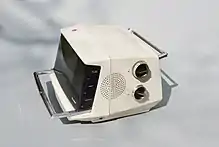
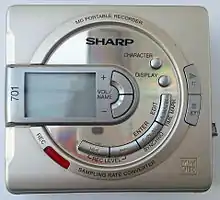
In 1953, Hayakawa Electric started producing the first Japan-made TV sets (the "Sharp TV3-14T").
In 1964, the company developed the world's first transistor calculator (the Sharp CS-10A), which was priced at JP¥535,000 (US$1,400). It took Sharp several years to develop the product as they had no experience in making computing devices at the time. Two years later, in 1966, Sharp introduced its first IC calculator using 145 Mitsubishi Electric-made bipolar ICs, priced at JP¥350,000 (about US$1000). Its first LSI calculator was introduced in 1969. This was the first pocketable calculator priced at less than JP¥100,000 (less than US$300), and turned out to be a popular item.[8] Also in the same era the company introduced the first microwave oven with a turntable between 1964 and 1966. The company was renamed Sharp Corporation in 1970.
Sharp produced the first LCD calculator in 1973. Sharp had a working relationship with Nintendo during the 1980s, and was granted licensing rights for the manufacture and development of the C1 NES TV (1983, later released in North America as the Sharp Nintendo Television), the Twin Famicom (1986), the Sharp Famicom Titler (1989), and the SF-1 SNES TV (1990). All of these units are considered collectors items on the secondary market. One of the company's main inventors of LCD calculators was Tadashi Sasaki.[9]
Sharp introduced low-cost microwave ovens affordable for residential use in the late 1970s. Sharp ventured into the high end stereo market in 1976 with the introduction of high end receivers, amplifiers, speakers, turntables and cassette players. The Optonica line as it was called, consisted of high quality and technically advanced components, that was expanded in 1979, to cover a broader selection of high end equipment. During this run, Sharp introduced digital technology to some of the Optonica products, along with the traditional analogue products, and offered a complete selection of models ranging from low power high end receivers to very powerful models. The line was again changed, in 1981, and moved mainly into digital high end, complete stereo systems with advanced technological features setting the trend towards the digital age. The line was discontinued after 1981, but the Optonica line was again re-introduced in the late 1980s for a high end line of television receivers and higher quality mass market audio products such as VCR's, surround sound receivers, CD cassette boom boxes, and portable cassette players.
2000-2012
Sharp's Mobile Communications Division created the world's first commercial camera phone, the J-SH04, in Japan in 2000.
Since 2000, Sharp heavily invested in LCD panel manufacturing plants: Kameyama in 2004, Sakai in 2009. The Sakai plant is still the only 10th generation LCD manufacturing plant on the globe and its best fit for production of 60-inch or larger panels. However, the 2008 financial crisis and strong Yen (especially against Won) significantly lowered world demand for Japanese LCD panels. Furthermore, the switch to digital TV broadcasting was virtually completed in Japan by the middle of 2011. Via Japanese government issued coupons for digital TV sets, consumers were encouraged to purchase digital TV sets until March 2011. This hit the Japanese LCD TV market, reducing it almost by half from 2010. All of those events strongly hit Sharp's LCD business. As the result, the Sakai LCD plant suffered a reduced operating rate until Q3 2012.
In June 2005 Sharp produced the largest LCD television at the time, with a display of 65 inches. It went on sale in August 2005 in Japan.[10]
From 2005 to 2010 Sharp was the biggest mobile phone brand in Japan. Since then it has been constantly switching places through financial quarters against rivals Fujitsu, Apple and Sony.
Sharp acquired a controlling stake in Pioneer Corporation in 2007.[11]
At CES 2007, Sharp introduced a prototype largest LCD TV, with a screen size of 108 inches.[12] In July 2008 Sharp announced that the model will go into production for the Japanese market.[13]
In 2008, Sharp collaborated with Emblaze Mobile on the Monolith, “…an ambitious project to design the ultimate holistic mobile device".[14] The project was never brought to market. Key software developers were later picked up by other companies.
On 25 June 2009, Sharp and Pioneer agreed to form a joint venture comprising their optical businesses, called "Pioneer Digital Design and Manufacturing Corporation".[15]
In 2012 Sharp unveiled the largest production TV at the time, with a screen size of 80 inches. It is part of the Aquos range and went on sale in Japan at around JP¥950,000.[16]
2012 - present
2012 was the 100th anniversary for Sharp but it announced the worst financial record in its history, with a loss of JP¥376 billion (US$4.7 billion) in April 2012. In September, Sharp announced job cuts.[17] In 2014, Sharp was able to stem losses and deliver a positive net income for its first quarter results.[18]
In March 2012 the Taiwan-based electronics company Hon Hai, trading as Foxconn, agreed to acquire a 10% stake in Sharp Corporation for US$806 million, and to purchase up to 50 percent of the LCD displays produced at Sharp's plant in Sakai, Japan.[19] In June 2012, Hon Hai chairman Terry Gou paid money for Sakai plant and got 50% ownership of the plant. However, since the announcement in March, Sharp's share price continued declining and reached JP¥192 on 3 August. Sharp deal's price was originally JP¥550 per share. Both companies agreed to renegotiate the share price, but they never came to an agreement.[20]
Sharp led the market share of mobile phones in the Japanese market in April 2012.[21] Sharp reportedly held 3rd place in mobile phone market share in the Japanese market in May 2015.[22]
Sharp announced it accepted a US$100 million investment from Samsung in March 2013.[23]
In 2013 Sharp developed the most efficient solar cell, converting a record 44.4% of sunlight into electricity.[24] In 2013, Sharp Corporation was the tenth-largest, by market share, television manufacturer in the world.[25] In Japan it has been a long-time leader.[26]
After years of huge losses in its overseas TV business, Sharp sold its Mexico TV factory to Chinese electronics manufacturer Hisense for $23.7 million in July 2015. The sale includes rights to use the Sharp brand name and all its channel resources in North and South America, except Brazil. This meant that Sharp has exited the TV market in the Americas (except Brazil).[27] It was a sign showing Sharp's rapid decline in that market, where it once was one of the leading manufacturers for LCD TVs a decade earlier.[28] Sharp's television market share in North America was 4.6% in 2015.[29] However Sharp remains the biggest television brand in the Japanese market.[26]
In October 2015 Sharp announced a smartphone that also works as a robot, called RoboHon. It would be sold in 2016 in Japan.[30]
Sharp began selling the world's first commercially available TV with a 8K resolution in October 2015.[31] The 85-inch LV-85001 model costs JP¥16 million (US$133,000). Japanese public broadcaster NHK will have test broadcasts at 8K starting 2016, with regular services expected by the time of the Tokyo 2020 Olympics.[32][33]
On 25 February 2016, Foxconn announced its intent to acquire a 66% controlling stake in Sharp for 700 billion yen (US$6.24 billion).[34] However, the deal was briefly delayed due to unforeseen financial liabilities; on 30 March 2016, Foxconn announced that it had agreed to pay US$3.5 billion for the stake instead, Foxconn wished to use the purchase to expand into direct-to-consumer product sales rather than serving as a contract manufacturer.[35]
In September 2016 Sharp unveiled the Sharp INTELLOS Automated Unmanned Ground Vehicle (A-UGV) at the ASIS International 62nd Annual Seminar and Exhibits (ASIS 2016) in Orlando, Florida.[36]
In March 2017, Demolition of Sharp's former headquarters began.[37]
On 28 April 2017, Sharp turned its first operating profit in three years, citing the restructuring efforts by Foxconn.[38]
In June 2017, Sharp sued its Chinese licensee Hisense for damaging the reputation of its brand, seeking an exit from its licensing agreement. Sharp accused the company of producing "shoddily manufactured" televisions under the Sharp name, including products they believed were in violation of U.S. safety standards for electromagnetic radiation, and the subject of deceptive advertising over their quality. Hisense denied that it engaged in these practices, and stated that it planned to defend itself in court and "will continue to manufacture and sell quality televisions under the Sharp licensed brands."[39][40] In February 2018, Sharp dropped the lawsuit against Hisense.[41] In 2019 Sharp re-acquired its own brand for use on TV's in the US market.[42]
In March 2020, in response to the coronavirus pandemic, Sharp announced it would use a TV factory with high-end clean rooms to manufacture surgical masks.[43][44]
Sharp acquired the remaining shares of Dynabook from Toshiba in August 2020, making Dynabook a wholly owned subsidiary of Sharp. Sharp had first purchased Dynabook from Toshiba in 2018.[45]
Products
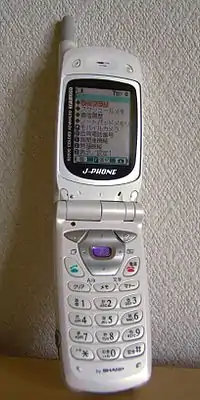
Core technologies and products include: LCD panels, solar panels, mobile phones, audio-visual entertainment equipment, video projectors, Multi-Function Printing Devices, microwave ovens, air conditioners, cash registers, CMOS and CCD sensors, and flash memory.
The first commercial camera phone was also made by Sharp for the Japanese market in November 2000. Recent products include the ViewCam, the Ultra-Lite notebook PC, the Zaurus personal digital assistant, Sidekick 3, and the AQUOS flat screen television.
Sharp manufactures consumer electronic products, including LCD televisions, sold under the Aquos brand, mobile phones, microwave ovens, Home cinema and audio systems, air purification systems, fax machines and calculators.[46]
For the business market, Sharp also produces projectors and monitors and a variety of photocopiers and Laser Printers, in addition to electronic cash registers and Point of sale technologies.[47]
For the private security industry, Sharp produces an Automated Unmanned Ground Vehicle (A-UGV) named INTELLOS, which utilizes a navigation surveillance platform also developed by Sharp. The system combines automation, mobility, and a variety of monitoring and detection capabilities to extend the impact of a traditional security force.[48]
Sharp Solar is a supplier of silicon photovoltaic (PV) solar cells,[49][50] and offers a solar TV.[51] In Q1 2010 the company made the highest revenues from production of solar PV systems.[52]
For the corporate meeting room market, Sharp was the first company to bring the Windows collaboration display to market, which is a 70inch interactive display with built-in unified communication equipment and an IoT sensor hub for measuring environmental room conditions. The Windows collaboration display is conceived to be seamlessly compatible with Microsoft's Office productivity products, as well as make use of the Microsoft Azure cloud services with the IoT sensor hub generated data.[53][54]
Operations
Japan
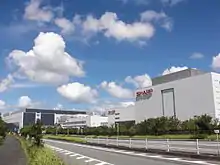
Net sales for the year 2003 were $16.8 billion.
The corporation employs 46,600 staff, of which around half live outside Japan.
It operates from 64 bases in 30 countries and its products are distributed in 164 countries worldwide. Many of its regional subsidiaries trade under the name Sharp Electronics.
Sharp was among the Top 100 R&D Spenders in a list published by the IEEE Spectrum magazine in 2002.
Sharp's headquarters are at 1 Takumi-chō, Sakai-ku, Sakai, Japan. Until the relocation to Sakai in 2016, the headquarters were in Abeno-ku, Osaka where Hayakawa restarted the business in the 1920s.[55]
Europe
In 2007 Sharp opened a LCD manufacturing plant in Poland.[56] The plant initially manufactured LCD modules using LCD panels imported from Sharp Japan.[57]
In September 2014, Sharp announced that Slovakian electronics company UMC (Universal Media Corporation /Slovakia/ s.r.o.) was acquiring an exclusive brand licence from Sharp and its European television and audio business UMC will also acquire Sharp's Polish factory. As part of the deal, Sharp will support the design and development of televisions sold by UMC under the Sharp brand.[58]
The same month, Sharp also announced a tie-up with Vestel in Europe for white goods. Vestel will sell Sharp-branded white goods (except air conditioners), such as refrigerators and microwave ovens manufactured by Sharp in Thailand and China. Sharp will also license its brand name to Vestel for volume home appliances such as refrigerators, washing machines and ovens. Sharp's remaining European business will then focus on the business-to-business sector including multi-function printers and energy solutions.
In 2017 Sharp acquired a majority (56.7%) shareholding in Skytec UMC, which included the UMC Poland factory.[59]
Factories
- Poland : Sharp Manufacturing Poland Sp. z o.o., in Toruń, Poland (Europe)
- Indonesia : Sharp also has a refrigerator manufacturing facility in Karawang, Indonesia, established 2014.[60]
- Malaysia : Sharp has an export-only Television factory at the HICOM Industrial Park in Shah Alam, Selangor. This plant manufactures television sets for export only to North America. Sharp also has two domestic appliances plant - the Batu Pahat plant in Johor that manufactures audio-visual Equipment like television sets and Blu-Ray players, and the Sungai Petani plant in Kedah that manufactures radios as well as kitchen appliances like blenders and rice cookers.[61] Formerly there was a plant in Petaling Jaya that manufactured television sets, VCRs, microwave ovens, washing machines and refrigerators, this plant was hit badly by the 1997 Asian financial crisis and shut down as Sharp moved the productions of the appliances to either Batu Pahat (TVs and VCRs) or Sungai Petani (microwave ovens), or out of the country altogether (refrigerators and washing machines) in a bid to reduce operating costs.
- (former) Mexico : LCD plant (Sharp Electrónica Mexico S.A. de C.V. SEMEX) - established as a color CRT TV plant in 1997; began LCD production in 2003; a second LCD plant on site was opened in 2007.[62] The facility and rights to use the Sharp brand on TVs in North America was sold to Hisense in 2015.[63]
Antitrust law violations
United States
On 8 November 2008, the United States Department of Justice announced that Sharp had agreed to pay $120 million (United States Dollar) as a criminal fine. According to the announcement, Sharp participated in conspiracies to fix the price of TFT LCD panel for Dell's computer monitors and laptops (2001–2005), Motorola's Razr phones (2005–2006) and Apple's iPod (2005–2006).[64]
Japan
On 18 December 2008, Japan Fair Trade Commission ordered Sharp to pay JP¥261 million (US$3 million) as criminal fine. According to the order, Sharp and Hitachi Display participated in the conspiracies to keep the price for TFT LCD panels for Nintendo DS and DS-Lite. Fine for Hitachi Displays was waived by JFTC leniency program.[65]
However, Sharp disagreed with the JFTC order and announced to begin appeal procedure against it on 2 February 2009.[66] On 31 July 2013, JFTC dismissed Sharp's appeal.[67]
Environmental record
.jpg.webp)
In November 2011 Sharp was ranked in 11th place by Greenpeace's re-launched Guide to Greener Electronics that ranks 15 electronics manufacturers according to their policies and practices to reduce their impact on the climate, produce greener products, and make their operations more sustainable. Greenpeace summarizes the corporation's environmental record thus: "Sharp supports a new renewable energy law in Japan but scores poor on all sustainable operations criteria".[68]
Sharp scored 3/10 and received most of its points on the Products criteria where the company was praised for the energy efficiency of its products with all of its TVs meeting the latest Energy Star standard. It also gained some points for having a relative long term target to reduce CO2 emissions by two percent (per production unit) compared to the previous year, yet sets out no clear target for absolute reductions. The company was also praised for its public support for a clean energy policy, after advocating the Japanese Government to increase the use of renewable energy.[68]
Sharp scored the fewest points in the guide in the Sustainable Operations category, scoring no points for chemical management due to not communicating commitments made on phasing out hazardous substances in its supply chain. The guide also notes that Sharp had lacked any initiative to address the issue of conflict minerals and the exclusion of paper sourced from suppliers involved in illegal logging or deforestation.[68]
Sponsorships
Sharp was the principal sponsor of Manchester United Football Club from 1983 until 2000, in one of the lengthiest and most lucrative sponsorship deals in English football.[69][70] Sharp's logo was on the front of United's shirts over these 17 years, during which the team won seven Premier League titles, five FA Cups, one Football League Cup, one UEFA Cup Winners' Cup, and one UEFA Champions League title. During 2002/03 and 2003/04 seasons, Sharp was sponsor on Red Star Belgrade shirts during their campaign in UEFA Cup and UEFA Champions League.
From 2001 to 2003, Sharp was the main shirt sponsor of Inverness Caledonian Thistle F.C. in the SFL
In June 2012, Sharp became name sponsor of a UCI World Tour cycling team, which thereupon became known as Garmin-Sharp.[71]
In September 2016, Sharp (in conjunction with Altodigital) signed a partnership with Stoke City F.C. for 2 years as an Official Platinum Partner.[72]
Product gallery
 Sharp 5P-37G boombox
Sharp 5P-37G boombox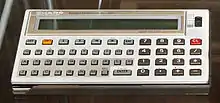
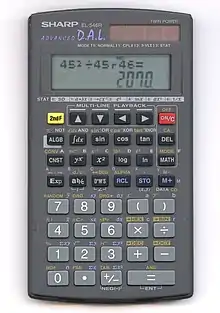 Sharp EL-546R scientific calculator
Sharp EL-546R scientific calculator Sharp CD-S400 Hi-Fi stereo system
Sharp CD-S400 Hi-Fi stereo system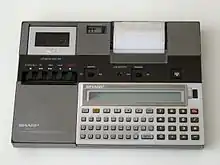 Sharp PC-1251 pocket computer
Sharp PC-1251 pocket computer.jpg.webp) Sharp PC-E220 pocket computer
Sharp PC-E220 pocket computer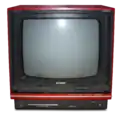 Sharp 14C-C1R television
Sharp 14C-C1R television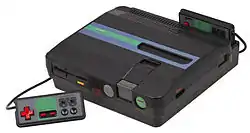 Sharp Twin Famicom licensed game console for Japanese market (1986)
Sharp Twin Famicom licensed game console for Japanese market (1986)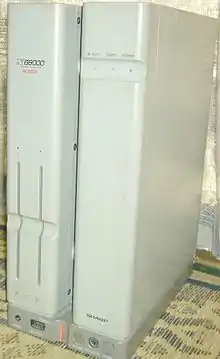 X68000 ACE-HD desktop computer for Japanese market (1988)
X68000 ACE-HD desktop computer for Japanese market (1988) Sharp 905SH mobile phone for Japanese market (2006)
Sharp 905SH mobile phone for Japanese market (2006)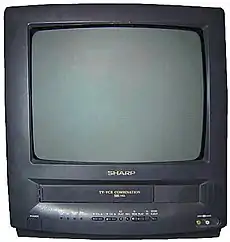 Sharp TV/VCR combo
Sharp TV/VCR combo Sharp AQUOS SH-12C mobile phone for Japanese market (2011)
Sharp AQUOS SH-12C mobile phone for Japanese market (2011)
Slogans
- "New Life Now" (Japan only, 1970s–1985)
- "New Life People" (Japan only, 1985–1988)
- "From Sharp Minds Come Sharp Products" (1980s)
- "Serikan Hidup Anda" (Malaysia only, 1980s–1990s)
- "Pertama & Satu-Satunya di Indonesia" (English: The First and Only in Indonesia, Indonesia only, 1997–2002)
- "Pertama & Satu-Satunya di Dunia" (English: The First and Only in the World, Indonesia only, 1997–2002)
- "Be Sharp" (2002–2016)[73]
- "Be Original" (2016–present)[74]
See also
References
- "data". ns6-tmp.sharp.co.jp.
- "代表取締役の異動並びに執行役員退任に関するお知らせ" (PDF).
- Annual Report 2019 (PDF), Sharp Corporation, March 2020, retrieved 6 December 2020
- Mochizuki, Takashi (13 August 2016). "Taiwan's Foxconn Completes Acquisition of Sharp". Wsj.com. Retrieved 26 July 2018.
- "Subscribe to read". Financial Times. Retrieved 26 July 2018. Cite uses generic title (help)
- Chanthadavong, Aimee. "Foxconn completes acquisition of Sharp". Zdnet.com. Retrieved 26 July 2018.
- "Eversharp history". Vintage Pens. Retrieved 15 July 2007.
- Odagiri, Hiroyuki (1996). Technology and Industrial Development in Japan. Oxford: Clarendon Press. p. 170. ISBN 0-19-828802-6.
- Aspray, William (25 May 1994). "Oral-History: Tadashi Sasaki". Interview #211 for the Center for the History of Electrical Engineering. The Institute of Electrical and Electronics Engineers, Inc. Retrieved 2 January 2013.
- "Sharp to produce World's largest LCD television at 65 inches". Gizmag.com.
- Reuters (21 September 2007). "Japan: Sharp Takes Stake in Pioneer (Published 2007)". The New York Times. ISSN 0362-4331. Retrieved 10 November 2020.
- "Sharp showcases World's largest LCD TV - 108 inches". Gizmag.com.
- "Sharp to Introduce World's Largest 108-Inch LCD Monitor for Commercial Applications; Now Accepting Orders - Press Releases:SHARP". Sharp-world.com.
- "The Monolith Project". Emblaze Mobile. Archived from the original on 3 March 2011. Retrieved 8 October 2008.
- "Pioneer and Sharp Sign Contract for Optical Disk Joint Venture" (PDF).
- "Sharp unveils largest TV on domestic market". The Japan Times.
- Atsuko Fukase. "Sharp Considers 10,000 Job Cuts". Wall Street Journal.
- "Consolidated Financial Results for the Year Ended March 31, 2014" (PDF). Sharp-world.com.
- "Foxconn owner Hon Hai buying 10 percent stake in Japanese electronics giant Sharp for $806M". The Washington Post. 27 March 2012. Retrieved 27 March 2012.
- "Deal reached with Sharp to renegotiate stake price: Hon Hai". The Daily China. 4 August 2012. Retrieved 19 November 2012.
- "In Japan, Smartphones Surpass Feature Phones among Newly Acquired Devices for First Time Ever". comScore, Inc.
- "iPhone accounted for 60% share of the Japanese mobile phone brand harmed Japan". hihuadu.com. 1 May 2015. Archived from the original on 19 November 2015.
- "Sharp to accept investment from Samsung, expand LCD panel supply". Mainichi Japan. 6 March 2013. Retrieved 7 May 2013.
- "Solar Cell Efficiency World Record Set By Sharp -- 44.4% - CleanTechnica". CleanTechnica.
- "TV manufacturers: LCD TV market share worldwide 2018". Statista.
- (C)Copyright 2006 ALLON Inc. "Market Share Ranking in Japan - Japan Business Resources". allon.info.
- Hisense (31 July 2015). "Hisense's Major Expansion: Acquiring Sharp America". Prnewswire.com.
- "What Does Sharp Exiting the TV Business Really Mean? - Consumer Reports". Consumerreports.org.
- Takashi Mochizuki (31 July 2015). "Sharp to Explore Options for LCD Panel Business". Wsj.com.
- "Video: Sharp has invented a smartphone that's also a ridiculously cute robot - Telegraph". Telegraph.co.uk. 7 October 2015.
- "First 8K TV screen to be put on sale by Sharp in October". BBC. BBC. Retrieved 5 September 2018.
- "Sharp will launch 8K TVs next month, at six-digit prices". ExtremeTech.
- Richard Lawler. "The first 8K TV will go on sale soon for over $130,000". Engadget. AOL.
- "Sharp accepts $6.24 billion takeover bid from Foxconn". The Verge. Retrieved 26 February 2016.
- "Foxconn finally agrees to Sharp takeover at lower price". The Verge. Vox Media. Retrieved 12 June 2017.
- "Sharp unveils rugged robotic guarding system at ASIS". Security Info Watch. Retrieved 17 November 2017.
- "Era over as Sharp's former headquarters meets wrecking ball". Nikkei Asian Review.
- "Restructuring sees Sharp post its first operating profit in three years in 2016". Japantimes. Retrieved 30 April 2017.
- "Sharp sues Hisense over 'shoddily' made TV sets". BBC News. Retrieved 12 June 2017.
- "Sharp says its US TVs are 'shoddily manufactured'". Engadget. Retrieved 12 June 2017.
- "Sharp drops suit against China's Hisense over TV brands'". Nikkei. Retrieved 2 March 2018.
- "Sharp to re-enter U.S. TV market after reaching agreement with Hisense on brand rights", japantimes.co.jp, 9 May 2019
- "Coronavirus: Sharp to use TV factory to make surgical masks". BBC News. 2 March 2020. Retrieved 2 March 2020.
- Byford, Sam (1 March 2020). "Sharp will use a TV factory to mass-produce face masks". The Verge. Retrieved 3 March 2020.
- "Toshiba is officially out of the laptop business". www.theverge.com.
- "SHARP calculators - Product portfolio". www.sharp-calculators.com.
- "Sharp - United Kingdom". www.sharp.co.uk.
- "Sharp Electronics | SharpUSA". Sharp USA.
- Takenaka, Kiyoshi (25 May 2008). "Sony says develops cost-efficient solar cells". Reuters.com.
- Daniel Glick, "Sharp’s Solar Solutions", Newsweek, 3 August 2009, pp. 16–23 (special advertising section)
- "Sharp Deutschland Solar - Photovoltaik und Solarmodule". Sharp-solar.com. Retrieved 10 October 2014.
- "Power & Energy Technology - IHS Technology". technology.ihs.com.
- "Windows collaboration display". www.sharp.co.uk. Retrieved 16 January 2020.
- "Driving opportunity for device partners in the era of the intelligent cloud and intelligent edge". The Official Microsoft Blog. 6 June 2018. Retrieved 16 January 2020.
- "Foxconn misses June target to finish Sharp takeover". Nikkei Asian Review. 1 July 2016. Retrieved 2 July 2016.
- Hammerschmidt, Christoph (29 August 2007), "Sharp opens TV plant in Poland", eetimes.com
- Williams, Martyn (13 April 2006), "Sharp to build LCD TV module plant in Poland", networkworld.com
- Strategic Alliance SHARP – UMC (press release), 26 September 2014
- Stronger together: Sharp Corporation acquires majority stake in Skytec UMC Ltd. (press release), 22 February 2017
- Sharp Holds Grand Opening Ceremony of Its New Plant in Karawang, Indonesia (press release), 12 February 2014
- Made in Malaysia and proud of it, says Sharp (news article), 8 September 2018
- Sharp Holds Opening Ceremony for Second Plant in Mexico - Achieves Integrated Production―from Manufacture of LCD Modules to Assembly of LCD TVs (press release), 2007
- Announcement regarding the Implementation of Structural Reforms of the LCD Television Business in the Americas including the Transfer of a Subsidiary and the Incurrence of Extraordinary Losses Due to Such Structural Reforms (PDF) (press release), 31 July 2015
- "LG, Sharp, Chunghwa Agree to Plead Guilty, Pay Total of $585 Million in Fines for Participating in LCD Price-fixing Conspiracies". US Department of Justice. 12 November 2008. Retrieved 20 June 2013.
- "Cease and Desist Order and Surcharge Payment Order against Manufacturers of TFT Liquid Crystal Display Module for "Nintendo DS" and "Nintendo DS Lite"". Japan Fair Trade Commission. 18 December 2008. Retrieved 21 June 2013.
- "Complaints against the Cease and Desist Order and the Administrative Surcharge Payment Order of the Japan Fair Trade Commission". Sharp Corp. 2 February 2009. Retrieved 21 June 2013.
- "About Sharp's appeal for TFT panel price cartel". Japan Fair Trade Commission (in Japanese). 13 July 2013. Retrieved 21 August 2013.
- "Guide to Greener Electronics - Greenpeace International". Greenpeace International. Archived from the original on 13 January 2011. Retrieved 16 November 2011.
- "Vodafone in £30m Man Utd tie-up". BBC News Online (Business). 11 February 2000. Retrieved 8 April 2008.
- "United must find new shirt sponsor". CNN.com International. 24 November 2005. Retrieved 8 April 2008.
- "Sharp to co-title Garmin cycling team - SportsPro Media". www.sportspromedia.com. Retrieved 21 January 2021.
- "STOKE CITY are delighted to welcome Sharp in conjunction with Altodigital as an Official Platinum Partner". Stokecityfc.com.
- "Sharp Commercial "Be Sharp" 2002". YouTube.
- "Sharp Introduces New Corporate Motto: Be Original. | Press Releases | Sharp Global". Sharp-world.com. Retrieved 2 March 2018.

